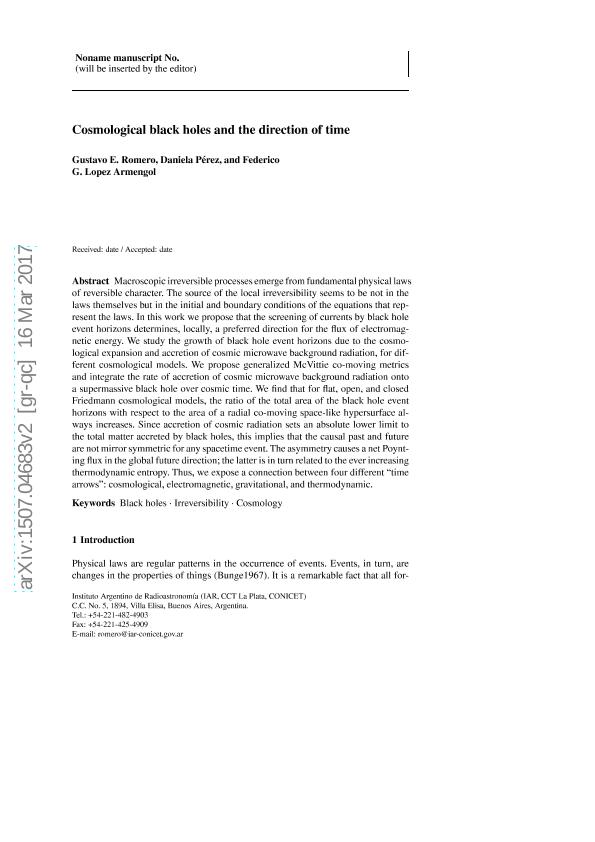Mostrar el registro sencillo del ítem
dc.contributor.author
Romero, Gustavo Esteban

dc.contributor.author
Pérez, Daniela

dc.contributor.author
Lopez Armengol, Federico Gaston

dc.date.available
2017-10-09T20:30:55Z
dc.date.issued
2017-03
dc.identifier.citation
Romero, Gustavo Esteban; Pérez, Daniela; Lopez Armengol, Federico Gaston; Cosmological black holes and the direction of time; Springer; Foundations of Science; 3-2017; 1-12
dc.identifier.issn
1233-1821
dc.identifier.uri
http://hdl.handle.net/11336/26280
dc.description.abstract
Macroscopic irreversible processes emerge from fundamental physical laws of reversible character. The source of the local irreversibility seems to be not in the laws themselves but in the initial and boundary conditions of the equations that represent the laws. In this work we propose that the screening of currents by black hole event horizons determines, locally, a preferred direction for the flux of electromagnetic energy. We study the growth of black hole event horizons due to the cosmological expansion and accretion of cosmic microwave background radiation, for different cosmological models. We propose generalized McVittie co-moving metrics and integrate the rate of accretion of cosmic microwave background radiation onto a supermassive black hole over cosmic time. We find that for flat, open, and closed Friedmann cosmological models, the ratio of the total area of the black hole event horizons with respect to the area of a radial co-moving space-like hypersurface always increases. Since accretion of cosmic radiation sets an absolute lower limit to the total matter accreted by black holes, this implies that the causal past and future are not mirror symmetric for any spacetime event. The asymmetry causes a net Poynting flux in the global future direction; the latter is in turn related to the ever increasing thermodynamic entropy. Thus, we expose a connection between four different “time arrows”: cosmological, electromagnetic, gravitational, and thermodynamic.
dc.format
application/pdf
dc.language.iso
eng
dc.publisher
Springer

dc.rights
info:eu-repo/semantics/openAccess
dc.rights.uri
https://creativecommons.org/licenses/by-nc-sa/2.5/ar/
dc.subject
Black Holes
dc.subject
Cosmology
dc.subject
Irreversibility
dc.subject.classification
Otras Ciencias Físicas

dc.subject.classification
Ciencias Físicas

dc.subject.classification
CIENCIAS NATURALES Y EXACTAS

dc.title
Cosmological black holes and the direction of time
dc.type
info:eu-repo/semantics/article
dc.type
info:ar-repo/semantics/artículo
dc.type
info:eu-repo/semantics/publishedVersion
dc.date.updated
2017-10-04T14:54:42Z
dc.journal.pagination
1-12
dc.journal.pais
Alemania

dc.journal.ciudad
Berlín
dc.description.fil
Fil: Romero, Gustavo Esteban. Provincia de Buenos Aires. Gobernación. Comisión de Investigaciones Científicas. Instituto Argentino de Radioastronomía. Consejo Nacional de Investigaciones Científicas y Técnicas. Centro Científico Tecnológico Conicet - La Plata. Instituto Argentino de Radioastronomía; Argentina
dc.description.fil
Fil: Pérez, Daniela. Provincia de Buenos Aires. Gobernación. Comisión de Investigaciones Científicas. Instituto Argentino de Radioastronomía. Consejo Nacional de Investigaciones Científicas y Técnicas. Centro Científico Tecnológico Conicet - La Plata. Instituto Argentino de Radioastronomía; Argentina
dc.description.fil
Fil: Lopez Armengol, Federico Gaston. Provincia de Buenos Aires. Gobernación. Comisión de Investigaciones Científicas. Instituto Argentino de Radioastronomía. Consejo Nacional de Investigaciones Científicas y Técnicas. Centro Científico Tecnológico Conicet - La Plata. Instituto Argentino de Radioastronomía; Argentina
dc.journal.title
Foundations of Science

dc.relation.alternativeid
info:eu-repo/semantics/altIdentifier/url/https://link.springer.com/article/10.1007/s10699-017-9527-x
dc.relation.alternativeid
info:eu-repo/semantics/altIdentifier/doi/http://dx.doi.org/10.1007/s10699-017-9527-x
Archivos asociados
